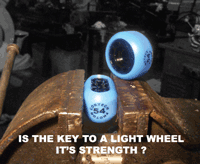Wheels
Wheels are made basically from urethane and have been so since the early 70's. Before then they were made from a weird "Clay" formula (composite plastic) and before that steel. The first urethane skateboard wheels were from a fork lift formula so they say.

Old school urethane wheels with cast in cup washer for separate ball bearings.
Sizes have varied a great deal over the years also. During the mid 70's they were around 56mm to 58mm During the 80's going from about 60mm up to about 65mm and a hardness around 95 to 97A. During the early 90's wheels took a dramatic drop in size and got harder. In 1992 wheels were down to a ridiculous 39mm and 101A hardness. The sizes gradually grew to what they are today with the average size around 50mm to 54mm for street and up to around 54mm to around 58mm for vert. Hardness at about 99A / 100A.
These days there are many formulas of urethane giving different characteristics. The formulas of each manufacturer is shrouded in secrecy. Mixtures of up to 8 different compounds could be included to give different rebound, hardness and colours etc. Urethane has excellent memory, it can undergo huge deformation only to rebound to exactly the same shape.

"Photons" by Cortech. pic courtesy Electric Urethane Mfg
The formulas are heated and mixed in a degasser vacuum tank to eliminate bubbles. The best wheels are hand poured into preheated metal moulds. More mass produced wheels are made with expensive automatic injection moulding machines. The moulds are kept at heat for a while for curing. Once they are hard enough, they are taken out of the moulds and left to cure for a further period of time at heat. Hand poured wheels tend to have the chemistry of the mix to set, where as injection moulded wheels tend to set via cooling.
The wheels may be then placed on a lathe and shaved down to the exact size. Depending on the type of mould used the backs of the wheels may be shaved back to the correct width and profile.
They are then left to cure for perhaps a few weeks at room temperature. Urethane is like a good wine, the older it is the better it gets.
Printing is done via a pad printer. The image of each separate colour is acid etched into a metal plate Ink is wiped over it. A soft silicon bulb is lowered down and picks up the ink impression off the plate. The bulb is then stamped onto the side of the wheel and the ink is left. Each colour is built up one after the other until the graphic is done.
The wheels are packaged up into sets of 4 with shrink wrap and shipped out.
The numbers on the side of the wheels means two different things. One number is the wheel diameter in millimetres, (mm) the other is the hardness or "Durometer" ending with usually an "A". There are two scales of hardness the "A" scale and the "D" scale. The "D" scale takes off where the "A" scale stops. The "A" scale goes from 1 to 100 the "D" scale starts again. With the new core wheels you could have a rating of 98A for the tyre and 75D for the core. The core is much harder but a lower number in the "D" scale. So technically the wheels that advertise a 101A durometer is incorrect.
Bigger wheels roll faster that's why vert/bowl and longboard/downhill boards have bigger wheels, it's for speed and air. Smaller wheels are used more for street skating where a little more control with technical tricks is required.
